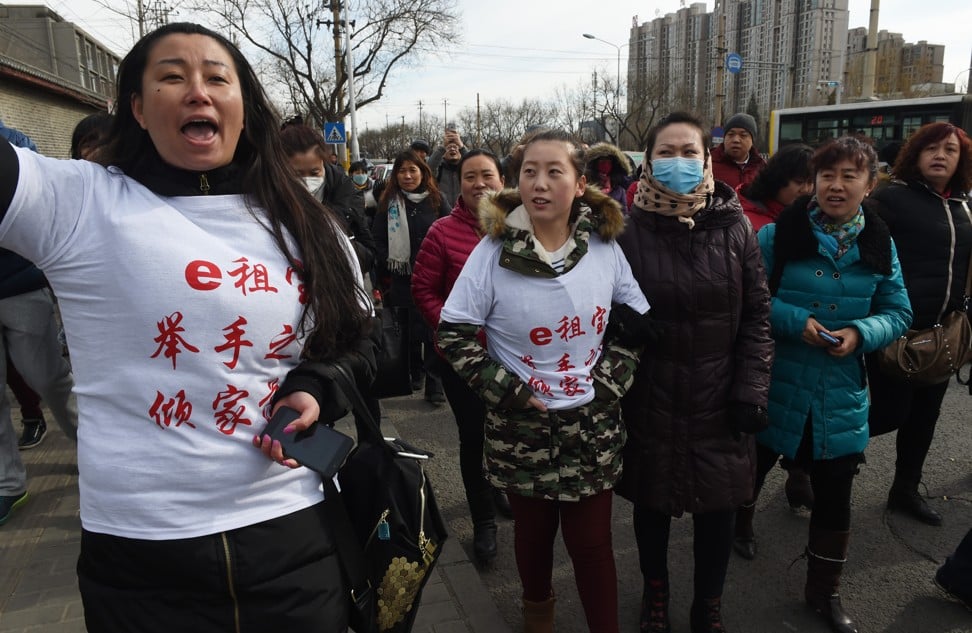
China regulatory failure to contain financial excesses putting off some foreign investors
- As long as demand for credit from cash-strapped small businesses and investors remains unaddressed, financial excesses are likely to recur, analysts say
- Despite regulatory clampdown P2P lending platforms are unlikely to disappear because banks are reluctant to lend to small companies due to credit risk
The inability of Chinese financial regulation to contain financial excesses has put off many foreign investors who would otherwise want to put their money into the country, analysts said.
The key problem is that Beijing has not yet found a way to meet the large demand by small private sector businesses, investors and entrepreneurs for credit through legal and regulatory compatible financing channels, analysts say. Until it does, it will continue to contend with a series of quasi-legal and highly speculative financing channels to meet that funding demand that will pose additional risks to the nation’s financial system.
Foreign investors also want to take advantage of the strong need for credit in China, but uncertainty over the regulatory environment has put many of them off.
China’s private sector is as capital starved today as it has been perhaps for 20 years or more
“There is huge demand and private equity funds in the West are beginning to lend. However, they are demanding sky-high rates due to the huge risk of lending to private corporates in China that often have unstable funding and during a time of slowdown in China. For these reasons, only the larger funds with good research teams will jump in with any strength,” said Andrew Collier, managing director at Orient Capital Research.
Oaktree Capital Group, one of the world’s largest alternative investment firms, told the South China Morning Post last year it would continue to invest in distressed debt and equities in China despite the growth of sour loans.
“China’s private sector is as capital starved today as it has been perhaps for 20 years or more,” said Peter Fuhrman, chairman and chief executive of China First Capital, an investment bank based in Shenzhen. “So there are creditworthy Chinese borrowers habituated to paying what by international standards quite high interest [rates]. The challenges remain not inconsiderable. At the top of the list is tougher government regulation on nonbank lending.”

Beijing has taken steps to tighten regulation of P2P platforms since 2015 amid a spate of high-profile company collapses and scandals that have rocked the industry and trapped the savings of millions of people.
The internet-based lending platforms match private investors with individuals and small companies that want to borrow, providing a lifeline for entities that have trouble accessing the traditional banking system.
The number of mainland P2P lenders has shrunk significantly over the past four years, from some 6,000 platforms operating in 2015 to just 572 in October this year, according to P2P tracking portal Waidaizhijia. But although the industry’s reputation for risky lending has attracted greater regulatory oversight, P2P lending continues to play an important role in China’s economy.
“P2P has looked like an attractive way to get capital to smaller firms and to regions of the country that have low access to bank lending,” said Collier.
“However, most of the money is going into speculative investments in property, along with established securities such as the better grade corporate bonds. The regulators go back and forth on how much freedom they want to give to this sector.”
P2P has looked like an attractive way to get capital to smaller firms and to regions of the country that have low access to bank lending
To tackle financial risks in the banking system, China has already taken a hard stance against shadow banking, which often involves many forms of off-balance-sheet lending from banks and nonbank financial firms, by rolling out new regulations to focus on supervising asset management businesses and products of commercial banks.
So far China’s effort seems to have made a significant difference to slowing the growth of the shadow banking industry. Rating agency Moody’s estimated that broad shadow banking assets shrank by nearly 1.7 trillion yuan (US$242 billion) in the first half of 2019 to 59.6 trillion yuan (US$8.4 trillion), the lowest level since the end of 2016.
Broad shadow banking assets declined only slightly to 64 per cent of nominal gross domestic production (GDP) at the end of June 2019 from 68 per cent at the end of 2018. But they were down 23 percentage points compared to the peak of 87 per cent of GDP at the end of 2016, Moody’s said.
Despite the crackdown by authorities, P2P lenders are likely to continue filling an important gap in the Chinese economy, according to analysts, although growth would be slower than during 2014 to 2018. Consultants Frost & Sullivan forecast P2P lending to grow in value to 2.17 trillion yuan (US$309.4 billion) by 2023, compared to 789 billion yuan (US$112 billion) in 2018.
“The explosive growth of the P2P industry since 2010 confirms there is huge and unmet demand for capital,” said Fuhrman. “Especially among smaller Chinese private sector companies.”

Part of the problem is that China’s banking system has not evolved to meet the demands of the private sector, which has been the engine of the country’s economic growth. Commercial banks prefer to lend to state-owned enterprises, which have implicit government backing, and are reluctant to lend to private companies because they are seen as being less creditworthy.
“In the past, non-performing [loans] were very high, so lending to small firms was discouraged,” Tian Guoli, the chairman of China Construction Bank, the country’s second biggest lender, said last year.
Squeezed between interest rates at P2P platforms that can be up to four times that charged by Chinese banks, and weak prospects of borrowing from large lenders, many small private companies have struggled to stay on top of debt.
The problem has been particularly acute through formal lending mechanisms such as the bond market. Between January and October this year, 93 private firms have defaulted on 278.7 billion yuan (US$39.6 billion) worth of Chinese bonds.
The overall default rate has now hit 1.51 per cent, a record high for the Chinese bond market since 2014, according to a report published by investment bank China International Capital Corporation last Friday. The default rate of a bond issued by a Chinese private company hit 11.82 per cent this year, nearly doubling from 6.18 per cent in 2018 and more than six times the rate of 1.89 per cent in 2017.
The sooner the legitimate nonbank lending sector gets cleaned up and back in business the better it will be for China as a whole
“While the overall liquidity in onshore bond market has improved, weak issuers will continue to face refinancing pressure over the next 12 months, because investors will remain risk averse towards them,” said Ivan Chung, an associate managing director at rating agency Moody's.
The People’s Bank of China has called for risks associated with the P2P industry to be resolved by the first half of 2020, while some provinces like Hunan in central China have moved to ban the platforms altogether.
However, analysts said that given that much of China’s private sector is in need of cash to repay debt, the industry was unlikely to disappear, even amid growing regulatory scrutiny.
“It’s better to have greater transparency and regulatory oversight,” said Fuhrman. “The lending doesn’t stop, but the money becomes more expensive and risky for borrowers. This has a deadweight cost to the Chinese economy. The sooner the legitimate nonbank lending sector gets cleaned up and back in business the better it will be for China as a whole.”

